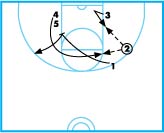Power post-up man offense leads to high-percentage shots
The following man-to-man offensive series is designed to provide good post-up opportunities for players 3, 4 and 5. It’s an extremely effective series because it isolates a post player and takes away any potential help-side defense by using a downscreen.
Power post-up ‘single entry’

If 1 makes the pass to 2, 3 posts up on the block. If 2 goes backdoor, 3 pops back to the wing and looks for the pass from 1.

DIAGRAM 2: Single entry (B). If 2 receives the pass from 1 on the perimeter, he or she quickly looks for 3 posting up. (If 2 had gone backdoor, he or she would come back to the ball side and post up. 3 would then look to pass to 2.) 1 screens down for 4 and then pops out to the weak-side wing. 4 comes out high, curls to the ball-side elbow and receives 2’s pass.

DIAGRAM 3: Single entry (C). 4 quickly reverses the ball to 1, and 1 looks to pass to make an entry pass into 5 on the block. After making the reversal pass, 4 breaks down and sets a screen for 3, who comes off the screen looking for a pass from 1 and a quick shot from the foul line.
If 3 doesn’t have a shot, he or she reverses the ball to 2, who’s set up behind the 3-point line on the weak side.
Power post-up ‘double-entry’

DIAGRAM 4: Double-entry (A). 4 and 5 are set up on the left low block in a double-stack. 1 dribbles toward the double-stack. 2 comes across the lane from the right low block cutting off the double-screen set by 4 and 5 and looking for a pass from 1. If 2 is open, 1 makes the pass.
After making the pass, 1 screens away for 3 at the weak-side elbow. 3 V-cuts to the basket, uses 1’s screen and comes to the top.

DIAGRAM 5: Double-entry (B). 4 curls around 5 and rolls through the lane. As this action is occurring, 2 has two options: pass to 5 on the low block for a post-up opportunity, or pass to 3 at the top.
If the pass goes to 3, he or she immediately looks to hit 4 cutting through the lane.

DIAGRAM 6: Double-entry (C). If 5 and 4 are defended, the ball is reversed to 1 on the right wing area. 1 looks to pass to 4 on the block or hits 5 popping to the foul-line area off a downscreen from 3. 5 looks for a quick shot as he or she comes off the screen. If no shot is available, the offense continues.
Power post-up ‘dribble-entry’

DIAGRAM 7: Dribble-entry (A). 1 dribbles toward 4 and 5’s double stack on the left side but then reverses and dribbles toward 3 on the right wing area at the foul-line extended. 2 clears to the weak side, setting up behind the double stack.
3 breaks to the basket and posts up on the ball-side low block. 1 looks to pass in to 3 for a post-up opportunity.

DIAGRAM 8: Dribble-entry (B). 5 screens down for 4, who comes off the screen and pops out high to the foul line. 1 passes to 4, who quickly reverses to 2 coming to the wing.

DIAGRAM 9: Dribble-entry (C). 2 looks first to pass inside to 5 for a post-up opportunity on the left low block. 4 downscreens for 3, who comes off the screen and looks for an open jump shot from the top. If 3 doesn’t have a good look, he or she swings the ball over to 1 on the right side.
1 looks to make a quick entry pass into 4 on the right low block. If the entry pass isn’t there, 1 brings the ball back out and the offense continues.









